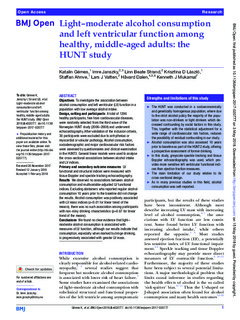| dc.contributor.author | Gemes, Katalin | |
| dc.contributor.author | Janszky, Imre | |
| dc.contributor.author | Strand, Linn B | |
| dc.contributor.author | László, Krisztina D. | |
| dc.contributor.author | Ahnve, Staffan | |
| dc.contributor.author | Vatten, Lars Johan | |
| dc.contributor.author | Dalen, Håvard | |
| dc.contributor.author | Mukamal, Kenneth J | |
| dc.date.accessioned | 2018-05-16T07:01:49Z | |
| dc.date.available | 2018-05-16T07:01:49Z | |
| dc.date.created | 2018-05-15T10:29:33Z | |
| dc.date.issued | 2018 | |
| dc.identifier.issn | 2044-6055 | |
| dc.identifier.uri | http://hdl.handle.net/11250/2498251 | |
| dc.description.abstract | Objectives To investigate the association between alcohol consumption and left ventricular (LV) function in a population with low average alcohol intake.
Design, setting and participants A total of 1296 healthy participants, free from cardiovascular diseases, were randomly selected from the third wave of the Norwegian HUNT study (2006–2008) and underwent echocardiography. After validation of the inclusion criteria, 30 participants were excluded due to arrhythmias or myocardial or valvular pathology. Alcohol consumption, sociodemographic and major cardiovascular risk factors were assessed by questionnaires and clinical examination in the HUNT3. General linear models were used to analyse the cross-sectional associations between alcohol intake and LV indices.
Primary and secondary outcome measures LV functional and structural indices were measured with tissue Doppler and speckle tracking echocardiography.
Results We observed no associations between alcohol consumption and multivariable-adjusted LV functional indices. Excluding abstainers who reported regular alcohol consumption 10 years prior to the baseline did not change the results. Alcohol consumption was positively associated with LV mass indices (p<0.01 for linear trend of the means); there was no such association among participants with non-risky drinking characteristics (p=0.67 for linear trend of the means).
Conclusions We found no clear evidence that light–moderate alcohol consumption is associated with measures of LV function, although our results indicate that consumption, especially when marked by binge drinking, is progressively associated with greater LV mass. | nb_NO |
| dc.language.iso | eng | nb_NO |
| dc.publisher | BMJ Publishing Group | nb_NO |
| dc.rights | Navngivelse-Ikkekommersiell 4.0 Internasjonal | * |
| dc.rights.uri | http://creativecommons.org/licenses/by-nc/4.0/deed.no | * |
| dc.title | Light-moderate alcohol consumption and left ventricular function among healthy, middle-aged adults: the HUNT study | nb_NO |
| dc.type | Journal article | nb_NO |
| dc.type | Peer reviewed | nb_NO |
| dc.description.version | publishedVersion | nb_NO |
| dc.source.journal | BMJ Open | nb_NO |
| dc.identifier.doi | 10.1136/bmjopen-2017-020777 | |
| dc.identifier.cristin | 1585040 | |
| dc.description.localcode | © Article author(s) (or their employer(s) unless otherwise stated in the text of the article) 2018. All rights reserved. No commercial use is permitted unless otherwise expressly granted. This is an Open Access article distributed in accordance with the Creative Commons Attribution Non Commercial (CC BY-NC 4.0) license. | nb_NO |
| cristin.unitcode | 194,65,20,0 | |
| cristin.unitcode | 194,65,25,0 | |
| cristin.unitname | Institutt for samfunnsmedisin og sykepleie | |
| cristin.unitname | Institutt for sirkulasjon og bildediagnostikk | |
| cristin.ispublished | true | |
| cristin.fulltext | original | |
| cristin.qualitycode | 1 | |

